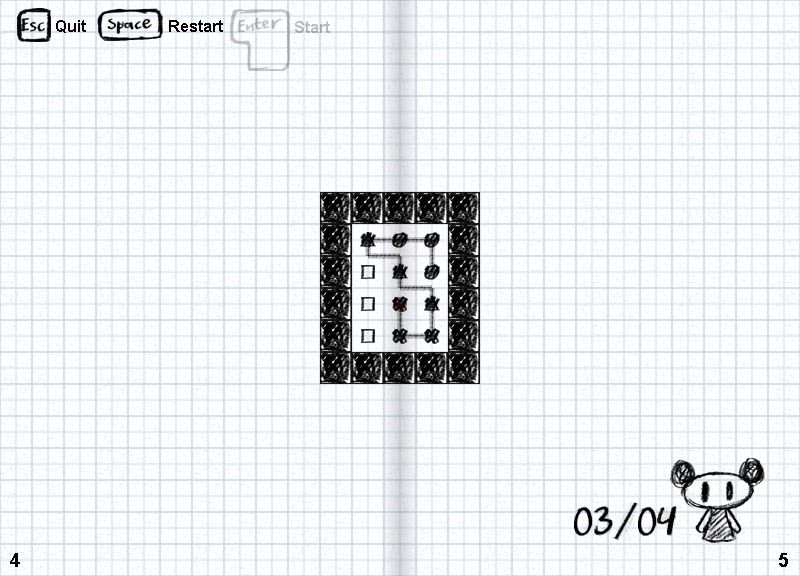Retro Replay Review
Gameplay
Tripline’s core gameplay revolves around drawing an uninterrupted line that connects symbols on a paper-like grid. Using simple arrow-key controls, players guide a pencil stroke across each level, aiming to form groups of three identical symbols without ever crossing the path. The puzzle unfolds gradually over 30 handcrafted grids, each offering a fresh layout of shapes and obstacles to keep the mind engaged.
(HEY YOU!! We hope you enjoy! We try not to run ads. So basically, this is a very expensive hobby running this site. Please consider joining us for updates, forums, and more. Network w/ us to make some cash or friends while retro gaming, and you can win some free retro games for posting. Okay, carry on 👍)
The rule set is elegantly minimal: no diagonal moves, no retracing steps, and the ever-present requirement to maintain triplets of identical icons along the route. This constraint-driven design gives Tripline an addictive “just one more try” quality, as you learn to anticipate how one move will affect your future options. Unlimited continues and instantaneous restarts ensure that frustration never overpowers the desire to untangle each puzzle.
Difficulty ramps up organically. Early levels teach you to spot pairing opportunities, while later challenges demand foresight and spatial reasoning. The absence of timers or move limits shifts focus squarely onto strategic planning, making each victory feel well-earned. Whether you breeze through early grids or spend minutes agonizing over a single junction, Tripline strikes a satisfying balance between accessibility and depth.
Graphics
Visually, Tripline adopts a charmingly minimalist aesthetic that simulates the look of pencil on lined paper. Grids are lightly tinted and symbols are crisply rendered, ensuring that each icon stands out clearly against the background. This stripped-down style keeps the spotlight on puzzle mechanics rather than flashy effects.
Subtle animations—such as the pencil’s shading trail and the faint highlight when you hover near a symbol—provide just enough feedback to make the interface feel alive. Though there are no particle explosions or dynamic lighting, the visual consistency reinforces the game’s analog, hand-drawn charm. The entire experience feels like working out puzzles in a notebook, appealing to fans of pen-and-paper brainteasers.
On higher-resolution displays, the clean lines remain sharp, and the pastel color palette is easy on the eyes during extended sessions. There’s no visual clutter or intrusive HUD elements; everything you need is right there in the grid. While Tripline’s graphics won’t win awards for technical prowess, they perfectly serve the gameplay and maintain a cohesive, paper-themed presentation.
Story
Tripline doesn’t feature a conventional narrative or cast of characters. Instead, the story emerges from your own journey through increasingly complex grids. Each level feels like a chapter in a silent graphic novel, where the act of connecting symbols becomes a metaphorical exploration of logic and pattern.
The lack of dialogue or cutscenes keeps you immersed in the puzzle world without distractions. You create your own sense of progression as the blank grids transform into intricate tapestries of lines and icons. This open-ended approach to storytelling lets players project their own motivations—be it to conquer the hardest level, achieve a perfect run, or simply enjoy a calming exercise in focus.
In a subtle way, Tripline’s “narrative” is about mastery and discovery. The satisfaction of completing a challenging puzzle carries emotional weight, and that sense of accomplishment becomes the game’s de facto storyline. For players who prefer puzzle-driven experiences over cinematic narratives, Tripline’s understated tale will resonate deeply.
Overall Experience
Tripline delivers a polished freeware puzzle package that feels both familiar and refreshingly original. Its blend of clear-cut rules, minimalist visuals, and thoughtful level design offers hours of contemplative gameplay. The unlimited continues system ensures that roadblocks never become road-ends, making it a welcoming title for puzzle newcomers and veterans alike.
One of Tripline’s greatest strengths is its portability: it runs on modest hardware and can be enjoyed in short bursts or marathon sessions. Whether you’re seeking a quick mental warm-up or a deeply focused puzzle spree, the game adapts to your playstyle. The lack of extraneous menus or optional modes means there’s no friction between launching the application and diving into brainteasers.
Overall, Tripline stands out as a testament to the enduring appeal of pen-and-paper puzzles in a digital age. Its straightforward mechanics and clean presentation may not dazzle with bells and whistles, but they underscore a core truth: when puzzle design is tight and intuitive, the experience is automatically engaging. If you’re in search of a cleverly constrained challenge that rewards patience and planning, Tripline is well worth your time.
 Retro Replay Retro Replay gaming reviews, news, emulation, geek stuff and more!
Retro Replay Retro Replay gaming reviews, news, emulation, geek stuff and more!








Reviews
There are no reviews yet.